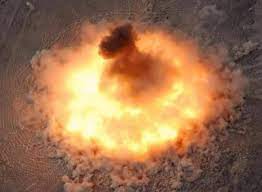
In a groundbreaking development, Chinese scientists have successfully tested a non-nuclear explosive device that produces a white-hot fireball lasting over two seconds, significantly longer than the brief flash of conventional TNT explosions. The weapon, developed by the China State Shipbuilding Corporation’s 705 Research Institute, is based on hydrogen fuel and produces an intense fireball with a temperature of 1,000 degrees Celsius, without the use of any nuclear materials.
The bomb, weighing just two kilograms, generates approximately 40% of the blast force of TNT, yet its thermal impact is far more extensive. According to a report by the South China Morning Post (SCMP), the fireball produced by the device lasts 15 times longer than the equivalent TNT blast. This extended duration, combined with its high temperature, allows the explosion to cause more severe thermal damage over a larger area.
The explosive device uses magnesium hydride, a silvery powder that, when activated by conventional explosives, undergoes rapid thermal decomposition. This reaction releases hydrogen gas, which ignites to create a sustained fireball. The hydrogen gas explosions are particularly notable for their minimal ignition energy, broad explosion range, and ability to spread flames rapidly across vast areas.
The primary purpose of the device, initially developed to bring gas to off-grid areas for clean electricity and heat, has potential military applications. Researchers believe it could be used to cover large areas with intense heat or to target high-value assets with focused destruction. The weapon’s thermal properties make it capable of melting aluminium alloys, adding to its potential lethality.
Although the device was tested in a controlled environment, where it delivered 40% of TNT’s blast force, its true military potential is still uncertain. It remains unclear how the People’s Liberation Army (PLA) intends to deploy such a weapon, but its powerful thermal effects could offer a strategic advantage in modern warfare.
The research on this non-nuclear explosive has been documented in a peer-reviewed paper published in the Journal of Projectiles, Rockets, Missiles And Guidance, and has sparked discussion regarding its future uses.
Sources By Agencies


